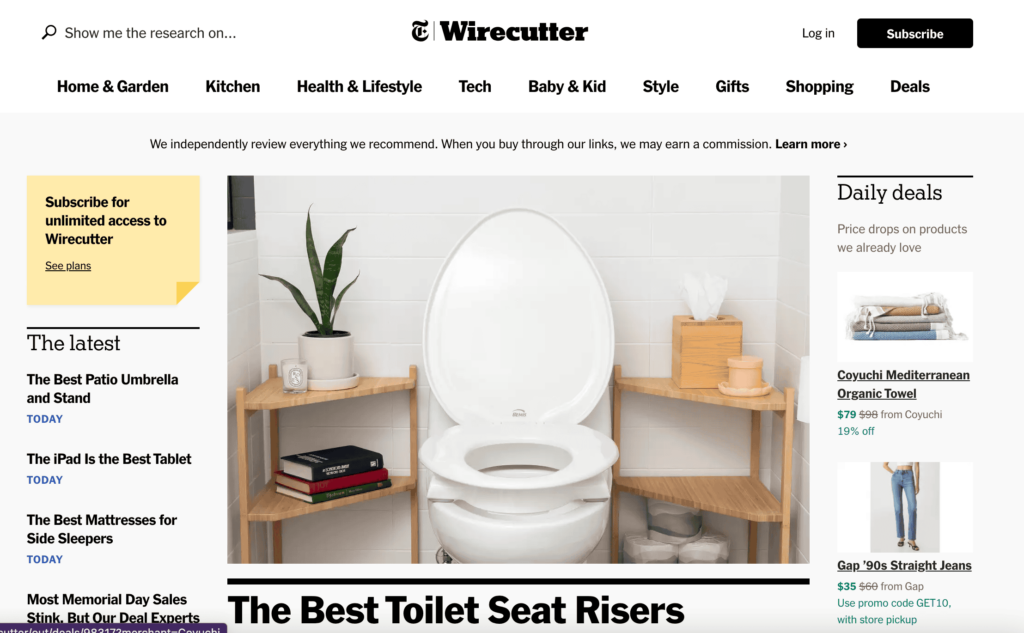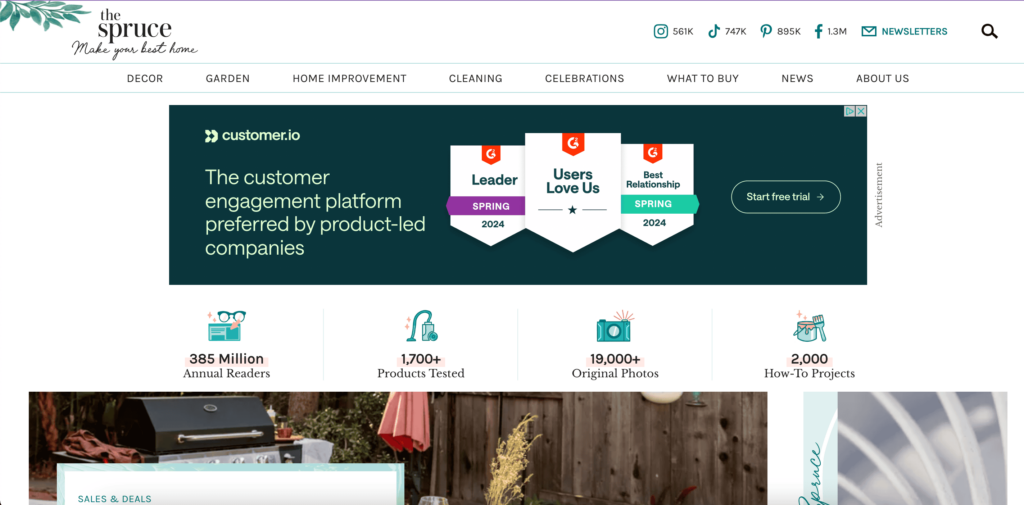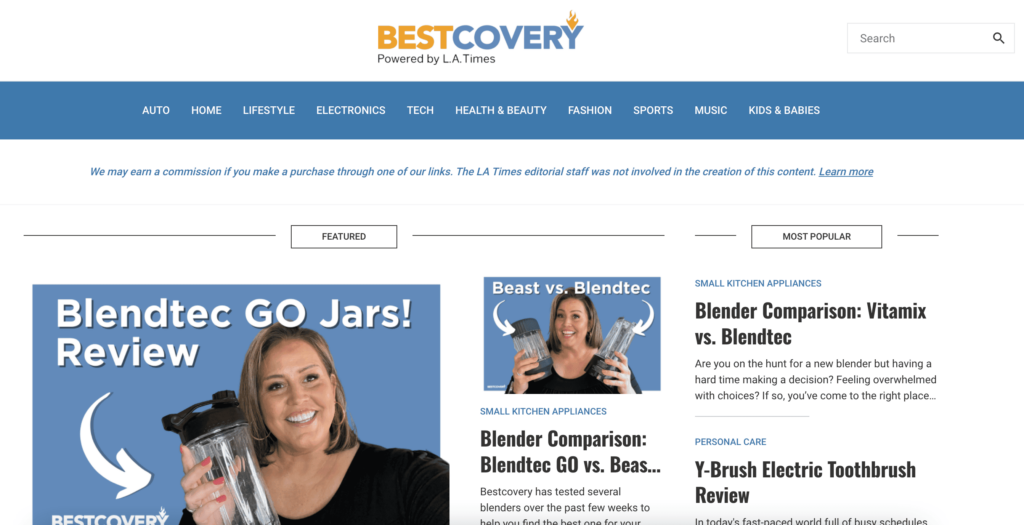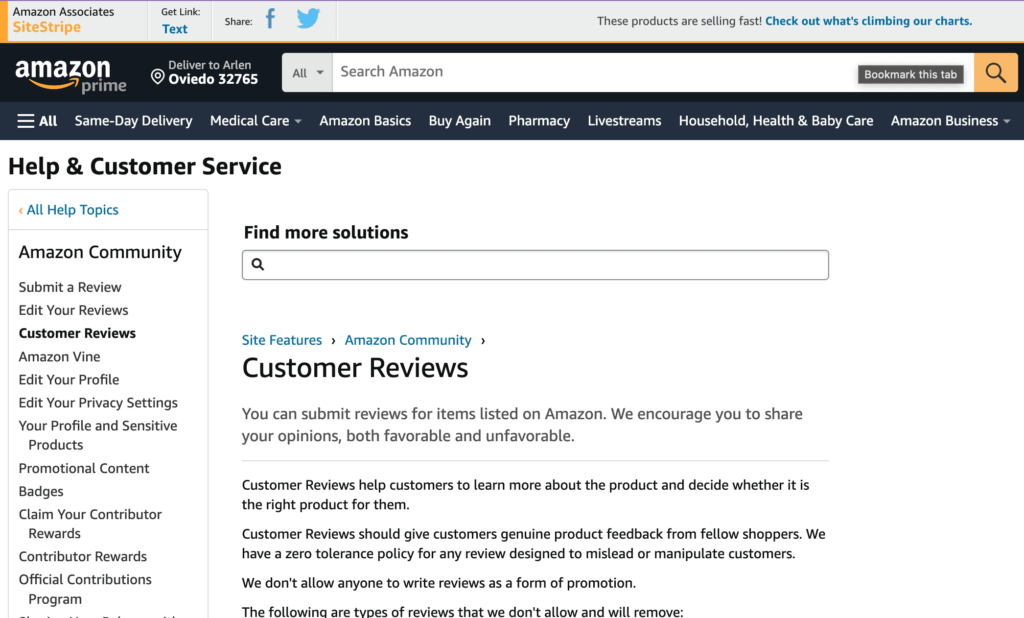Have you ever felt overwhelmed by the sheer number of products available online? From gadgets to kitchen appliances, the options seem endless. This is where product review sites come in handy. Simply put, a product review site is a platform that collects and publishes reviews of various products from both experts and users. These reviews provide valuable insights, helping you make informed purchasing decisions.
Imagine you’re looking for a new laptop. You could spend hours sifting through manufacturer descriptions and user manuals. Or, you could visit a site like Consumer Reports, which offers detailed, unbiased reviews on a wide range of products. These sites not only save you time but also provide expert opinions and real user experiences.
The primary purpose of product review sites is to build trust and transparency between consumers and businesses. By offering honest and comprehensive reviews, these sites help consumers feel confident about their purchases. In turn, businesses can gain valuable feedback and improve their products based on customer reviews.
Table of Contents
ToggleKey Features of a Good Product Review Site
Not all product review sites are created equal. To truly benefit from these platforms, it’s essential to know what makes a review site reliable and user-friendly. Here are some key features to look for:
Comprehensive and Unbiased Reviews
A good product review site should offer thorough and unbiased reviews. Look for sites that employ expert reviewers who test products rigorously and provide detailed analyses. For instance, Wirecutter is known for its in-depth testing process and comprehensive reviews. According to a survey by Statista, 62% of consumers trust reviews on expert sites like Wirecutter.
User-Generated Content
In addition to expert reviews, user-generated content is crucial. Sites like Amazon and Best Products allow users to leave their own reviews and ratings. This creates a wealth of diverse opinions and experiences. When browsing user reviews, look for detailed comments that mention specific pros and cons of a product. This can provide a more rounded view of the product’s performance.
Easy Navigation and Searchability
A user-friendly interface is essential for a good review site. You should be able to easily search for products and filter reviews based on various criteria, such as price, rating, and date. For example, CNET offers a clean and intuitive layout, making it easy to find reviews and compare products. A study by the Baymard Institute found that 67% of users leave a site if they experience navigational issues.
Verified Purchases
Trustworthy review sites often include a verification system to ensure that reviews come from actual purchasers. Amazon, for instance, labels reviews from verified buyers, helping to weed out fake reviews. According to a report by BrightLocal, 79% of consumers trust online reviews as much as personal recommendations, but they prefer verified reviews to ensure authenticity.
Regular Updates
The best review sites are regularly updated with the latest products and reviews. Technology and consumer preferences evolve quickly, so it’s important to have access to current information. Sites like Gizmodo and Wirecutter frequently update their content to reflect new releases and trends.
The Importance of Product Reviews for Consumers

Ever bought something online and felt a little uneasy about it? You’re not alone. The vast world of online shopping can feel like a maze, and product reviews are the guiding lights that help us navigate it. Trust and credibility are the bedrock of these reviews.
When you read a product review, you’re looking for honest feedback from real users. Authentic reviews can significantly boost your confidence in a product. For instance, a study by BrightLocal found that 79% of consumers trust online reviews as much as personal recommendations. This statistic highlights the immense trust placed in these reviews.
Consider the example of Amazon. Their system of verified purchases ensures that the reviews you’re reading come from actual buyers. This feature adds a layer of credibility that’s hard to beat. When you see a product with thousands of positive reviews from verified buyers, it’s easier to trust that the product is as good as it claims to be.
Let’s take it a step further. Imagine you’re shopping for a new smartphone. You find two options: one with hundreds of detailed, positive reviews and another with a few vague comments. Which one are you more likely to trust? The answer is clear. Detailed reviews build credibility, making your shopping decision much simpler.
Influencing Purchase Decisions
Product reviews don’t just build trust; they play a crucial role in influencing purchase decisions. Think about the last time you bought something online. Did you scroll through the reviews before making a choice? Most likely, yes. In fact, 93% of consumers say online reviews impact their purchasing decisions, according to a survey by Podium.
Let’s break it down with an example. You’re looking at two different brands of noise-canceling headphones. One has numerous positive reviews praising its sound quality and comfort, while the other has mixed reviews with complaints about durability. Even if the second option is cheaper, you’re more likely to choose the first one based on the reviews.
But it’s not just about the number of reviews. The content of these reviews matters too. Reviews that include specific details about the product’s performance, pros, and cons are incredibly valuable. For instance, a review that mentions how well a vacuum cleaner handles pet hair can be the deciding factor for pet owners.
Moreover, reviews can highlight features you might not have considered. A case in point is the rise of video reviews. Platforms like YouTube are filled with detailed product reviews, where users can see the product in action. According to Think with Google, 55% of consumers use online videos for shopping research. These visual reviews can influence decisions by providing a more comprehensive view of the product.
Additionally, seeing a mix of positive and negative reviews can give a more balanced perspective. No product is perfect, and knowing the potential downsides can help set realistic expectations. This transparency can actually make you more confident in your decision, as you’re fully aware of what to expect.
The Importance of Product Reviews for Businesses
Have you ever wondered how some brands seem to shine brighter than others? A significant part of their glow comes from the power of positive product reviews. For businesses, these reviews are more than just feedback; they are vital tools for building and enhancing brand reputation.
Think of it this way: when customers share their positive experiences, they essentially become brand ambassadors. Their reviews act as word-of-mouth recommendations that can reach a vast audience. According to a study by BrightLocal, 88% of consumers trust online reviews as much as personal recommendations. This means a single glowing review can have the same impact as a friend’s advice.
Take the case of Apple. The tech giant has a legion of loyal customers who regularly leave positive reviews about their products. This constant stream of favorable feedback has helped Apple maintain a stellar reputation. Even when a product has mixed reviews, the sheer number of positive ones often outweighs the negatives, reinforcing the brand’s overall credibility.
Moreover, responding to reviews—both positive and negative—shows that a business values its customers’ opinions. This interaction can significantly boost a brand’s image. For instance, a survey by ReviewTrackers found that 53% of customers expect businesses to respond to their online reviews within seven days. By engaging with customers, businesses can demonstrate their commitment to customer satisfaction, further enhancing their reputation.
In addition to boosting credibility, positive reviews can also improve a brand’s online visibility. Search engines like Google consider review ratings and the frequency of reviews when ranking businesses in search results. Higher visibility means more potential customers will see the business, increasing the likelihood of more sales.
Improving Product Development
Product reviews are not just about enhancing brand reputation; they are also a treasure trove of insights for improving product development. Imagine having a direct line to your customers’ thoughts and opinions. Reviews provide precisely that, offering valuable feedback that can drive innovation and improvement.
For example, consider the case of Dyson. The company is known for its innovative home appliances, and much of this innovation is driven by customer feedback. Dyson actively monitors reviews and uses the insights gained to refine and enhance their products. When customers mentioned difficulties with the weight of their vacuum cleaners, Dyson responded by developing lighter models. This responsive approach has helped Dyson stay ahead of the competition.
Reviews can highlight both strengths and weaknesses. Positive comments can confirm what you’re doing right, while negative feedback can pinpoint areas for improvement. This kind of direct, unfiltered input is invaluable for making informed decisions about product development. According to a report by PowerReviews, 82% of businesses use customer reviews to improve their products.
Additionally, reviews can reveal trends and preferences that might not be apparent through traditional market research. For instance, if multiple customers mention a desire for a specific feature, it’s a clear sign that there’s demand for it. Incorporating these features can lead to products that better meet customer needs and preferences.
Let’s not forget the role of reviews in quality control. Consistent complaints about a particular issue can alert a company to potential defects or problems that need addressing. This proactive approach can prevent larger issues down the line and ensure higher customer satisfaction.
To sum up, product reviews are essential for businesses, serving as a cornerstone for building brand reputation and a catalyst for product development. They provide a direct line to customer thoughts, helping businesses make informed decisions that enhance their products and services. So, the next time you see a review, remember it’s more than just a comment—it’s a valuable tool for growth and improvement.
Types of Product Review Sites
Expert Review Sites
When it comes to making informed purchasing decisions, expert review sites are invaluable. These platforms employ professionals who rigorously test and evaluate products, providing detailed and unbiased reviews. If you’ve ever wondered whether a product lives up to its hype, expert reviews can offer the clarity you need.
Take Wirecutter, for instance. This site is renowned for its meticulous testing process. The reviewers at Wirecutter spend weeks, sometimes months, using and comparing products in real-world settings. Their goal? To identify the best options in various categories, from tech gadgets to kitchen appliances. According to Pew Research, 53% of online shoppers rely on expert reviews to make informed decisions, underlining the trust consumers place in these professional opinions.
Another example is CNET, which specializes in tech product reviews. CNET’s team of experts provides in-depth assessments of the latest gadgets, offering insights into performance, features, and value for money. This level of expertise is particularly crucial for complex products like smartphones and laptops, where technical specifications can be overwhelming for the average consumer.
Why do expert reviews matter so much? For starters, they provide a level of detail and analysis that user-generated reviews often lack. Experts can break down the technical aspects of a product, explaining what makes it stand out or fall short. This thoroughness helps consumers understand whether a product will meet their needs.
Moreover, expert review sites usually adhere to high editorial standards, ensuring that their reviews are fair and unbiased. For example, Consumer Reports operates on a non-profit basis and buys all the products it tests to maintain objectivity. This commitment to impartiality reassures consumers that the reviews are trustworthy.
User-Generated Review Sites
While expert reviews are invaluable, user-generated review sites offer a different but equally important perspective. These platforms rely on the collective wisdom of everyday consumers who share their experiences with products. Sites like Amazon, TripAdvisor, and Yelp are prime examples of user-generated review platforms that have transformed the way we shop and make decisions.
User-generated reviews provide a wealth of real-world experiences. For instance, Amazon reviews often include detailed feedback from people who have used the product for various purposes. This diversity of opinions can help you gauge how a product performs under different conditions. According to a survey by PowerReviews, 97% of consumers read product reviews before making a purchase, highlighting the significance of these user insights.
Consider TripAdvisor, a site that aggregates user reviews for hotels, restaurants, and attractions worldwide. The platform allows travelers to share their experiences and rate various aspects of their stay. These reviews can reveal insights that expert reviews might miss, such as the friendliness of the hotel staff or the cleanliness of the rooms. The sheer volume of reviews on TripAdvisor can help you identify consistent patterns and make more informed travel choices.
User-generated review sites also foster a sense of community and trust. When you read reviews from other consumers, you often get a sense of authenticity and relatability. These reviews can include personal anecdotes and practical tips that resonate on a more personal level. For example, a parent might share how a stroller performs in different terrains, providing valuable information for other parents considering the same purchase.
Additionally, user-generated reviews can cover a broader range of products and services. While expert review sites might focus on high-demand or high-ticket items, user reviews can be found for almost anything, from niche gadgets to everyday household items. This extensive coverage means you’re likely to find reviews for even the most obscure products.
Incorporating both expert and user-generated reviews into your research process can give you a well-rounded view of a product. While expert reviews provide depth and technical insight, user reviews offer a breadth of real-world experiences and practical tips. Together, they help you make more confident and informed purchasing decisions.
So, whether you’re buying a new smartphone or planning your next vacation, tapping into the insights from both expert and user-generated review sites can significantly enhance your shopping experience. Remember, the more information you have, the better equipped you are to choose products that truly meet your needs and expectations.
Criteria for Choosing the Best Product Review Sites
Accuracy and Reliability of Reviews
When searching for the best product review sites, accuracy and reliability should be at the top of your list. But how do you determine if a review site is trustworthy? Let’s break it down.
Accurate reviews are based on thorough testing and honest feedback. Look for sites that provide detailed analyses and avoid vague or overly general comments. Sites like Consumer Reports and Wirecutter are renowned for their rigorous testing procedures. They purchase products independently and put them through extensive tests to ensure their reviews are both accurate and unbiased. For instance, Wirecutter’s approach involves weeks or even months of real-world use to evaluate products thoroughly.
Reliability also comes from consistency. A reliable review site will consistently provide high-quality, accurate reviews over time. It’s not just about one or two good reviews; it’s about a track record of dependable information. For example, Consumer Reports has been a trusted source of product reviews since 1936, earning consumer trust through decades of reliable service.
Another way to gauge the reliability of a review site is to check if they disclose their review process and any potential conflicts of interest. Transparency is key. Sites that openly discuss how they test products and mention any affiliations with manufacturers are more likely to be trustworthy. For instance, if a site receives free products from manufacturers, it should clearly state this to maintain credibility.
Consider user-generated review sites as well. Platforms like Amazon use mechanisms such as verified purchases to enhance the reliability of reviews. According to BrightLocal, 91% of consumers trust reviews from verified users more than anonymous ones. This verification process helps ensure that the reviews are coming from real customers who have actually used the product.
It’s also beneficial to look for review sites that aggregate scores from multiple sources. For example, Metacritic compiles reviews from various critics and users, providing an overall score that can help you gauge a product’s quality at a glance. This aggregation can balance out individual biases and give a more rounded view of the product.
In short, when evaluating the accuracy and reliability of review sites, focus on their testing procedures, transparency, consistency, and use of verified reviews. These elements can help you discern whether the reviews are truly reliable and worthy of your trust.
User Interface and Experience
A product review site might have the most accurate reviews, but if it’s a pain to navigate, you’re less likely to use it. That’s where user interface (UI) and user experience (UX) come into play. A well-designed site makes it easy to find the information you need quickly and effortlessly.
Take a moment to think about your favorite websites. What makes them stand out? Chances are, they have a clean, intuitive design that guides you smoothly from one section to another. For instance, CNET offers a streamlined interface where you can easily search for products, read reviews, and compare different options without getting lost in a maze of links.
Good UI means clear navigation, logical organization, and responsive design. This is particularly important for review sites because users often need to sift through large amounts of information. A site like Best Products uses categories and filters to help you narrow down your search, making it easier to find exactly what you’re looking for.
UX goes hand in hand with UI but focuses more on the overall feel of the site. It’s about how pleasant and efficient the experience is. For example, TripAdvisor not only provides a wealth of user-generated reviews but also integrates maps, booking options, and user photos seamlessly. This comprehensive approach enhances the overall user experience, making trip planning much more enjoyable.
Interactive features can significantly enhance UX. Look for review sites that offer comparison tools, user-friendly filters, and engaging multimedia content. Sites like PCMag allow users to compare specifications side by side, making it simpler to decide between similar products. According to a study by HubSpot, 38% of users will stop engaging with a website if the layout is unattractive, emphasizing the importance of good design.
Another key aspect of UX is the site’s loading speed. Slow sites can frustrate users and increase bounce rates. A report by Google found that as page load time goes from one to three seconds, the probability of bounce increases by 32%. Therefore, a review site that loads quickly and efficiently keeps users engaged and satisfied.
Incorporating these elements into the design of product review sites can dramatically improve user satisfaction. When choosing a review site, pay attention to its layout, ease of navigation, and additional features that enhance your browsing experience. After all, the best reviews are only helpful if you can access and understand them easily.
Top 10 Best Product Review Sites
In today’s digital age, consumer product review sites have become invaluable resources for shoppers seeking honest feedback and detailed insights before making a purchase. These platforms provide a wealth of user-generated content, expert reviews, and comprehensive comparisons that help consumers make informed decisions. From tech gadgets to household items, these top review sites cover a wide range of categories, ensuring that there is something for everyone. In this section, we will explore the leading consumer product review sites that stand out for their reliability, thoroughness, and user-friendly interfaces.
Consumer Reports
Consumer Reports is a powerhouse in the world of product reviews. Known for its rigorous and unbiased testing, this non-profit organization buys all the products it tests to ensure impartiality. Founded in 1936, Consumer Reports has built a reputation for providing detailed and reliable reviews on everything from cars to kitchen appliances. One of the standout features is their comprehensive testing process, which often involves weeks or months of use before publishing a review.
Consumer Reports is particularly valuable for big-ticket items like cars and home appliances. For example, their annual car reliability surveys, which gather data from thousands of vehicle owners, are considered some of the most reliable sources for automotive information. According to a study by Pew Research, 53% of online shoppers rely on expert reviews from sites like Consumer Reports to make informed decisions.
Best Products
Best Products offers a wide range of reviews across various categories, from tech gadgets to beauty products. What sets Best Products apart is its engaging and user-friendly format. The site combines expert reviews with curated lists that are easy to navigate, making it simple to find the top recommendations in any category.
Best Products often includes lifestyle images and relatable scenarios in their reviews, which help readers visualize how the products can fit into their own lives. This approach not only makes the content more engaging but also more practical. For example, their reviews of fitness equipment might include tips on how to incorporate these tools into your daily routine.
CNET
CNET is a go-to source for tech enthusiasts. Specializing in reviews of the latest gadgets, software, and consumer electronics, CNET provides in-depth evaluations that cover performance, design, and value. Their reviews are written by experienced tech journalists who conduct hands-on testing to ensure accuracy.
One of the strengths of CNET is its comparison tools, which allow users to compare specs and features of different products side by side. This feature is particularly useful for tech products, where small differences in specifications can make a big impact. According to a survey by PowerReviews, 97% of consumers read product reviews before making a purchase, highlighting the importance of reliable sources like CNET.
Wirecutter
Wirecutter, a subsidiary of The New York Times, is known for its meticulous and exhaustive testing process. Their reviews are the result of extensive research and hands-on testing, often involving multiple experts and several months of evaluation. Wirecutter’s goal is to provide definitive recommendations for the best products in each category.
For example, when reviewing the best laptops, Wirecutter’s team might test dozens of models under various conditions to determine which ones offer the best performance, battery life, and value. Their in-depth guides often include alternative picks for different needs and budgets, ensuring that there is a recommendation for everyone.
Byrdie
 Byrdie is a beauty and wellness site that provides in-depth reviews on skincare, makeup, haircare, and wellness products. What sets Byrdie apart is its focus on expert opinions and real-world testing. The site employs beauty experts who test products and provide honest feedback based on their professional experience.
Byrdie is a beauty and wellness site that provides in-depth reviews on skincare, makeup, haircare, and wellness products. What sets Byrdie apart is its focus on expert opinions and real-world testing. The site employs beauty experts who test products and provide honest feedback based on their professional experience.
Byrdie’s reviews often include detailed ingredient analyses and usage tips, making them incredibly informative. For instance, a review of a new moisturizer might explain the benefits of its key ingredients and offer advice on how to incorporate it into your skincare routine. This level of detail helps readers understand not just what to buy, but how to use it effectively.
The Spruce
The Spruce specializes in home and garden products, offering practical and easy-to-understand reviews. Whether you’re looking for the best vacuum cleaner or tips on gardening tools, The Spruce provides detailed reviews that cater to a wide audience.
The Spruce is known for its user-friendly format and practical advice. Reviews often include step-by-step guides and how-to articles, which can help readers get the most out of their purchases. For example, a review of a new lawnmower might include tips on maintenance and usage, ensuring that you can keep your lawn looking great all year round.
Bestcovery
Bestcovery focuses on finding the best products in a wide range of categories, from electronics to home goods. What makes Bestcovery unique is its straightforward, no-nonsense approach to reviews. The site provides concise summaries of the top products in each category, making it easy to find the best options quickly.
Bestcovery’s reviews are ideal for readers who want a quick and reliable recommendation without wading through long articles. For example, their review of the best kitchen blenders might include a top pick for overall performance, a budget option, and a premium choice, catering to different needs and price points.
Amazon Reviews
Amazon Reviews is one of the most well-known user-generated review platforms. With millions of reviews covering virtually every product imaginable, Amazon provides a wealth of information from real users. The key advantage of Amazon Reviews is the volume and diversity of feedback, which can give you a comprehensive view of a product’s performance.
Amazon’s review system includes verified purchase badges, which help identify reviews from actual buyers. This feature enhances the credibility of the reviews. According to a report by PowerReviews, 82% of consumers say the content of a review is more important than the number of reviews, highlighting the value of detailed user feedback found on Amazon.
G2
G2 is a leading review site for software and business services. G2’s reviews are written by verified users, providing insights into the performance and usability of various software products. The site uses a unique algorithm to score products based on user satisfaction and market presence, making it easier to compare options.
G2’s detailed reviews and ratings are particularly useful for businesses looking to invest in new software. For example, a small business owner looking for a CRM system can use G2 to find detailed reviews and compare different options based on features, pricing, and user satisfaction. This can significantly streamline the decision-making process.
In conclusion, these top 10 product review sites offer a wealth of reliable information to help you make informed purchasing decisions. Whether you’re looking for expert opinions, user-generated feedback, or detailed comparisons, these sites have you covered. So next time you’re in the market for a new product, be sure to check out these trusted sources to ensure you’re making the best choice.
How to Utilize Product Review Sites Effectively
So, you’ve found a product review site and you’re ready to dive in. But how do you make the most of the information available? Analyzing review content effectively is key to making informed purchasing decisions.
First, pay attention to the details in the reviews. Look for specific information about the product’s performance, features, and any potential issues. For example, if you’re reading reviews for a new smartphone, details about battery life, camera quality, and user interface can be very telling. A review that simply states, “Great phone!” isn’t as helpful as one that explains why the phone is great.
Next, consider the overall tone and consistency of the reviews. Are multiple reviewers highlighting the same strengths and weaknesses? This can indicate a common experience among users. For instance, if several reviewers mention that a vacuum cleaner has excellent suction but is heavy to maneuver, you can weigh the importance of these factors based on your own needs. According to a study by PowerReviews, 97% of consumers read product reviews before making a purchase, showing how critical detailed reviews are for decision-making.
It’s also useful to look for comparative reviews. These reviews often compare the product with similar items, providing context for its performance. For example, a review comparing different brands of fitness trackers can highlight how one brand stands out in terms of battery life or accuracy. This comparative insight can be invaluable, especially when you’re torn between a few options.
Additionally, don’t overlook the negative reviews. While it’s easy to focus on positive feedback, negative reviews can provide important insights into potential drawbacks. For instance, a series of reviews mentioning that a blender’s motor burns out quickly could be a red flag. By understanding the potential issues, you can make a more balanced and informed decision.
Identifying Authentic Reviews
In the digital age, not all reviews are created equal. Some reviews can be fake or biased, often posted by bots or individuals with vested interests. So, how do you identify authentic reviews?
Start by looking for reviews with a “verified purchase” tag. Sites like Amazon use this tag to indicate that the reviewer has actually bought the product. Verified reviews tend to be more trustworthy since they come from real customers. According to BrightLocal, 91% of consumers trust online reviews as much as personal recommendations, but this trust increases when the reviews are verified.
Check the reviewer’s profile. Authentic reviewers often have a history of writing reviews, and their profiles might include other information such as location or additional product reviews. If a profile only has one glowing review or seems overly enthusiastic, it might be suspicious.
Look at the language and content of the review. Authentic reviews usually have a balanced tone and include both pros and cons. Reviews that are overly positive without any negatives can be a red flag. For example, a review that says, “This product is perfect in every way!” without elaborating might be less reliable than one that provides specific details about what works well and what doesn’t.
Pay attention to the timing of the reviews. If a product suddenly receives a flood of positive reviews within a short period, it could be a sign of fake reviews. Authentic reviews tend to trickle in steadily over time. Tools like Fakespot and ReviewMeta can help analyze the authenticity of reviews by looking for patterns that might indicate manipulation.
Lastly, consider the context in which the reviews are written. Authentic reviews often include real-life scenarios or specific use cases. For example, a review of a camping tent that describes how it held up during a windy night provides more credible insight than a generic comment about the tent being “good.”
Google’s Recent Product Review Updates
Navigating the world of product reviews has always been a challenge, and Google’s recent updates have made it even more critical to stay informed. Google continuously refines its algorithms to improve the quality of search results, and its recent changes specifically target product reviews. These updates aim to promote high-quality, in-depth reviews and diminish the visibility of superficial or fake reviews.
The core of these updates is Google’s effort to reward content that demonstrates expertise, authoritativeness, and trustworthiness (E-A-T). For example, Google’s algorithm now places a higher value on reviews that provide detailed analysis, comparisons, and insights from real users. If you’re writing a product review, including specific data, personal experiences, and expert opinions can significantly boost your content’s ranking.
Additionally, Google’s algorithm now favors reviews that cover both positive and negative aspects of a product. This balanced approach helps ensure that the reviews are genuine and not overly biased. For instance, a review that highlights both the strengths and weaknesses of a new smartphone model is likely to rank higher than one that only lists its benefits.
Google also emphasizes the importance of original images and videos in product reviews. Reviews that include these elements tend to rank better because they provide unique and valuable perspectives that text alone cannot convey. According to a study by Search Engine Journal, content with visuals is 94% more likely to be viewed than text-only content. This means that incorporating high-quality images and videos of the product in use can significantly enhance the review’s effectiveness and ranking.
Moreover, Google has updated its guidelines to crack down on fake reviews. The algorithm now includes advanced detection methods to identify and penalize reviews that appear to be manipulated. This includes fake positive reviews that inflate a product’s rating and negative reviews that unfairly damage a competitor’s reputation. As a result, genuine reviews with verified purchase information and detailed feedback are more likely to be highlighted.
Impact on Review Sites
These algorithm changes have had a profound impact on review sites. For one, sites that consistently produce high-quality, in-depth reviews have seen an increase in their visibility and traffic. Sites like Wirecutter and Consumer Reports, known for their detailed and unbiased reviews, have benefited from these updates. Their commitment to thorough testing and comprehensive analysis aligns well with Google’s emphasis on quality content.
On the flip side, review sites that relied on thin, low-quality content have experienced a decline in their search rankings. For example, sites that aggregated short, generic reviews without offering much depth or original insight have been penalized. This shift encourages review sites to invest in better content creation strategies to maintain or improve their rankings.
User-generated review platforms like Amazon have also felt the impact. Amazon’s efforts to verify purchases and reduce fake reviews align well with Google’s updated criteria. However, even Amazon has had to enhance its review moderation processes to ensure that the reviews displayed are genuine and helpful. According to a report by BrightLocal, 82% of consumers have read a fake review in the past year, which highlights the ongoing challenge of maintaining review authenticity.
For smaller review sites or new entrants, these changes present both challenges and opportunities. While the bar for content quality is now higher, those that can meet these standards have a better chance of competing with established players. New review sites must focus on providing detailed, balanced, and authentic reviews, supported by high-quality multimedia content, to gain visibility in search results.
In practical terms, if you’re running a review site or contributing reviews, consider these tips to align with Google’s recent updates:
- Provide In-Depth Analysis: Go beyond surface-level observations. Include detailed pros and cons, comparisons with similar products, and personal usage experiences.
- Use Multimedia: Incorporate original photos and videos to provide a richer, more engaging review.
- Ensure Authenticity: Focus on genuine feedback. If you’re soliciting user reviews, encourage detailed and honest responses.
- Balance Your Content: Present both positive and negative aspects of the product to create a trustworthy review.
By adapting to these algorithm changes, review sites can improve their search rankings and provide more value to their readers, ultimately making it easier for consumers to find trustworthy and detailed product reviews.
How to Spot Fake Reviews
In the vast sea of online reviews, spotting fake ones can feel like a daunting task. However, there are several telltale signs that can help you identify and avoid fake reviews.
Firstly, look at the language used in the review. Genuine reviews often contain specific details about the product and the user’s experience with it. They may mention unique aspects or features that stood out, both positive and negative. In contrast, fake reviews tend to be overly generic and excessively positive or negative. For example, a review that only says, “This product is amazing! Best purchase ever!” without any specifics is a red flag.
Check the reviewer’s profile for authenticity. Real users usually have a history of multiple reviews and interactions. If a profile has only one review, especially if it’s overly enthusiastic or critical, it might be fake. Also, be cautious of profiles with generic usernames and no personal details. According to BrightLocal, 91% of consumers trust reviews with detailed and personal information more than anonymous ones.
Pay attention to the timing of the reviews. If a product receives a large number of glowing reviews within a short period, it could indicate that the reviews are fake. Genuine reviews tend to trickle in steadily over time. For instance, if you notice a sudden spike in five-star reviews shortly after a product launch, it might be worth investigating further.
Use review analysis tools like Fakespot and ReviewMeta. These tools analyze the language and patterns in reviews to detect suspicious activity. They can provide an overall grade for the trustworthiness of the reviews on a product page, helping you make more informed decisions.
Look for consistency in feedback. If multiple reviews mention the same pros and cons, it’s likely they’re genuine. For example, if several reviews of a vacuum cleaner mention its powerful suction but also note that it’s a bit noisy, these consistent points can be trusted. In contrast, if reviews are inconsistent and all over the place, some might be fake.
Best Practices for Leaving Reviews
Leaving a helpful and trustworthy review is a great way to contribute to the online community. Here are some best practices to keep in mind when writing your review.
First and foremost, be honest. Share your genuine experience with the product, highlighting both the positives and negatives. For example, if you’re reviewing a pair of running shoes, mention how they perform on different terrains, their comfort level, and any durability issues you encountered. Honesty helps other consumers make informed decisions and builds your credibility as a reviewer.
Provide specific details. Rather than saying, “This product is great,” explain why you think it’s great. Did the blender crush ice effortlessly? Was the laptop’s battery life as advertised? Specifics make your review more useful. A study by PowerReviews found that reviews with detailed information are 78% more likely to influence a purchase decision.
Include photos or videos if possible. Visual evidence can greatly enhance the credibility and usefulness of your review. For example, showing a picture of the assembled furniture or a video demonstrating how a gadget works can provide valuable insights that words alone cannot convey. According to a report by HubSpot, content with relevant images gets 94% more views than content without images.
Be concise but thorough. Aim for a balanced review that covers the main aspects without being overly long. Short paragraphs and bullet points can make your review easier to read and digest. For example:
- Performance: “The laptop runs multiple programs smoothly, but the fan gets noisy during intensive tasks.”
- Design: “Sleek and lightweight, perfect for travel.”
- Value: “A bit pricey, but worth it for the features offered.”
Avoid using jargon or overly complex language. Keep your review accessible to a wide audience. Think about what information would have been helpful to you when you were considering the purchase, and include that in your review.
Finally, update your review if necessary. If your opinion about the product changes over time, whether for better or worse, it’s helpful to provide an update. This ongoing feedback can be very valuable for future buyers. For example, if a product worked well initially but started having issues after a few months, mentioning this in an updated review can give others a more complete picture.
By following these best practices, you can write reviews that are not only trustworthy and helpful but also valuable contributions to the online community.
Conclusion
We’ve covered a lot of ground in this guide to finding and using product review sites effectively. Let’s recap the essential takeaways:
Understanding Product Review Sites: We started by defining what product review sites are and their importance. These platforms provide invaluable insights from both experts and everyday users, helping you make more informed purchasing decisions.
The Importance of Product Reviews for Consumers: Product reviews build trust and credibility. Detailed, balanced reviews can significantly influence your purchase decisions by highlighting both the strengths and weaknesses of a product.
The Importance of Product Reviews for Businesses: For businesses, reviews enhance brand reputation and offer critical feedback for product development. Positive reviews can boost a brand’s image, while constructive criticism can drive improvements.
Types of Product Review Sites: We explored the differences between expert review sites and user-generated review sites. Each type offers unique benefits, from in-depth professional analyses to a wide range of personal experiences.
Criteria for Choosing the Best Product Review Sites: Accuracy, reliability, user interface, and overall user experience are key factors. Trustworthy sites provide detailed, honest reviews and are easy to navigate.
Top 10 Best Product Review Sites: We highlighted some of the top product review sites, including Consumer Reports, Best Products, CNET, Wirecutter, OveReview, Byrdie, The Spruce, Bestcovery, Amazon Reviews, and G2. Each site has its strengths, catering to different needs and preferences.
How to Utilize Product Review Sites Effectively: Analyzing review content and identifying authentic reviews are crucial skills. Detailed, balanced reviews and verified purchase tags are indicators of reliable feedback.
Google’s Recent Product Review Updates: Google’s algorithm changes emphasize high-quality, in-depth reviews. Review sites must focus on providing detailed, balanced, and authentic reviews to maintain visibility and trust.
Frequently Asked Questions About Product Review Sites: Spotting fake reviews and best practices for leaving reviews help maintain the integrity of the review ecosystem. Honest, detailed reviews with specific examples and visuals are the most helpful.
Final Recommendations for Consumers and Businesses
For Consumers: When shopping online, make product reviews your best friend. Always look for detailed, balanced reviews that highlight both the positives and negatives. Utilize multiple review sites to get a comprehensive view. Don’t hesitate to use tools like Fakespot or ReviewMeta to verify the authenticity of reviews. Remember, a well-informed decision can save you time, money, and disappointment.
For Businesses: Embrace the feedback loop that reviews provide. Encourage your customers to leave honest reviews and engage with their feedback constructively. Highlight positive reviews on your website and social media to build trust with potential customers. Use the constructive criticism to improve your products and services. Transparency and responsiveness can significantly enhance your brand reputation.
For Both: Stay updated with the latest changes in Google’s algorithm to ensure your reviews are visible and credible. As the digital landscape evolves, so too must your strategies for giving and receiving feedback. Detailed, honest, and balanced reviews are the cornerstone of a trustworthy online marketplace.
In the end, whether you’re a consumer looking for the best product or a business aiming to improve your offerings, leveraging product reviews effectively can lead to better decisions and greater satisfaction. Happy reviewing!










